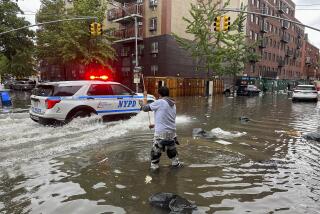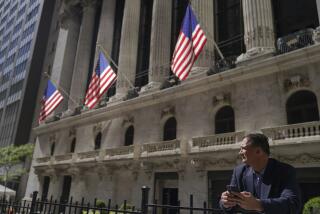Wall Street prepares for reopening of NYSE, other markets
- Share via
New York Stock Exchange trader Doreen Mogavero normally leaves her Staten Island home at 7:30 a.m. for a comfortable 45-minute drive to work.
But with Wall Street scrambling to get the nation’s financial markets up and running, a groggy Mogavero will leave 2 1/2 hours earlier Wednesday to have plenty of time to navigate heavy traffic, blocked roadways and cramped parking.
“I’m going to do the best I can,” said Mogavero, a 34-year NYSE veteran. “As New Yorkers we’re a pretty resourceful group. We’ll figure something out.”
STATE BY STATE: Snow piles up; beaches wash away
From the iconic NYSE to the grandiose offices of nearby Goldman Sachs, Wall Street is getting back to business Wednesday — proudly if a bit apprehensively.
After being shut down for two days, the financial district is simply hoping to make it through the day without any breakdowns in its systems. Pulling that off would rank as a big success for the city and its hallmark industry.
“These are the world’s biggest markets, and to open them is a really big deal,” said Miranda Mizen, director of equities research at Tabb Group, a consulting firm. “You’ve got to be able to open. The world watches New York.”
VIDEOS: East Coast hit by deadly storm
The NYSE has been the focal point of the recovery efforts. Surging seawater from the monster storm came within two blocks of the exchange building at the intersection of Wall and Broad streets.
More than four dozen NYSE employees have worked around the clock, sleeping overnight on cots and couches, to bring trading back up.
Aside from the technical challenges, the exchange faces a balancing act in trying to reopen quickly while risking a technology snafu that could blemish its image. Rival Nasdaq faces a similar problem as its systems are switched on Wednesday.
PHOTOS: Massive U.S. storms
“The NYSE is in a position where it’s damned if it does and damned if it doesn’t,” said Benn Steil, an expert on stock exchanges at the Council on Foreign Relations. “Staying closed for another day would not help their image. It would give the impression they themselves are no longer reliable.”
The need for a smooth reopening is crucial after a string of computer glitches on Wall Street.
Trading problems marred Facebook Inc.’s high-profile initial public offering in May. Software bugs nearly felled the major brokerage Knight Capital Group in August. And $1 trillion briefly vanished from the stock market in the so-called flash crash in 2010.
U.S. exchanges spent much of Tuesday running extensive tests, including so-called circuit breakers put in place after the flash crash to prevent wild swings in the market.
Given that traders haven’t been able to buy or sell stocks for two full days, the markets may get off to a rocky start as investors react not only to the tempest but also to corporate earnings releases and to Friday’s government jobs report.
Even though financial markets have grown increasingly computerized and fragmented in recent years, Cyclone Sandy posed major low-tech challenges.
The NYSE had to make sure trucks could deliver more fuel for its headquarters’ backup generators, Larry Leibowitz, chief operating officer of NYSE Euronext, the exchange’s operator, said Tuesday afternoon.
Getting employees to work was also a hurdle, given that Sandy all but shut down the New York region’s mass transportation — not just Manhattan’s subway but commuter trains to New Jersey, Westchester and Connecticut. Leibowitz said NYSE was planning carpools and buses for employees, some of whom might sleep over at the exchange.
Mogavero is optimistic that the NYSE can avoid problems.
“We want to do it right, and we want to make sure that once we get open that we stay open,” Mogavero said.
More to Read
Inside the business of entertainment
The Wide Shot brings you news, analysis and insights on everything from streaming wars to production — and what it all means for the future.
You may occasionally receive promotional content from the Los Angeles Times.










